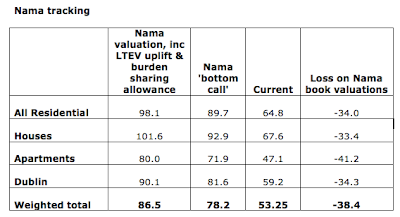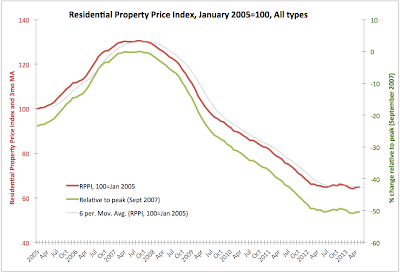At last, with a delay of some 4 weeks we have the Mortgages Arrears data for Ireland for Q1 2013. The delay was caused by (my sources tell me) a reporting glitch from one of the institutions.
At any rate, the CBofI release of the data does not seem to fit any of the conspiracies theories bandied about, so let's assume that it was a glitch. That raises a question - what sort of a glitch can disrupt reporting of something as simple as arrears without having any effect whatsoever on any lender's other operations? I shall leave this question for you to ponder.
What do the figures tell us? As usual, my suggestion is - ignore the spin in the media, read CBofI own release, read
https://www.mortgageholders.ie/ position (due tomorrow am) and let's focus on raw numbers here.
In Q1 2013, number of outstanding mortgages accounts relating to principal dwelling houses/residences (PDH) stood at 774,109, down on 792,096 in Q4 2012 - a decline of 2.27% q/q, but an increase of 1.3% y/y. With BTLs added, total number of residential mortgages in the country stood at 923,504 or 2.01% below Q4 2012 and 20.9% above Q2 2012 when reporting began. Much of changes in the total numbers of mortgages in recent quarters is accounted for by classification changes.
While the number of mortgages outstanding dropped by 2.27% for PDH, volumes of loans relating to mortgages decline by far smaller 0.79%.
So observation 1: exits remain based predominantly on pay downs of older vintage, smaller mortgages, leaving the remaining pool of mortgages more toxic.
Total number of accounts in arrears in relation to PDH stood at 142,118 in Q1 2013, down 1.2% from 143,851 accounts in Q4 2012, but up 15.6% y/y. Total outstanding amounts relating to PDH accounts in arrears was up 2.85% q/q at EUR25.485 billion (up 11.21% y/y) and underlying volumes of accumulated arrears rose to EUR1.932 billion (up 7.81% q/q and 39.87% y/y).
Observation 2: Marginal decrease in arrears-impacted mortgages accounts was associated with deeper deterioration in terms of the volumes of PDH mortgages impacted by arrears. The problem got slightly more concentrated and much more toxic.
Number of accounts in arrears in relation to BTL rose to 39,371 in Q1 2013, up 3.73% q/q and up 13.4% y/y. Total outstanding amounts relating to BTL accounts in arrears was up 2.84% q/q at EUR10.891 billion (up 10.94% y/y) and underlying volumes of accumulated arrears were at EUR1.178 billion (down 1.29% q/q and up 40.13% y/y). Note: y/y comparatives for BTLs are only referencing 9 months period since the end of Q2 2012 - the first period for which we have data available.
Observation 3: BTLs continued to tank across the board, although cumulated arrears amounts did decline q/q. Assuming there were no reclassifications, this suggests some write-offs by the banks of defaulted loans.
Total (PDH+BTL) number of accounts in arrears stood at 181.489 in Q1 2013, down 0.17% from 181,806 accounts in Q4 2012, but up 11.4% on Q2 2012 - the earliest for which we have data available for BTL. Total outstanding amounts relating to all mortgages accounts in arrears was up 2.85% q/q at EUR36.376 billion a rise of 9.02% on Q2 2012. However, the core number, relating to cumulated arrears has jumped significantly more than any other arrears-related parameter. This rose to EUR3.11 billion in Q1 2013 up 4.17% q/q and +33.83% on Q2 2012.
Observation 4: across all residential mortgages, the problem of arrears became slightly marginally more concentrated and significantly more toxic.
In Q1 2013, 185,263 PDH mortgages accounts were either at risk of default or defaulting (the category that includes, per my methodology, all mortgages in arrears, all repossessions and all mortgages that are restructured and currently are not in arrears), which is 0.81% down on Q4 2012 and +13.97% up on Q1 2012. At the same time, there were 52,991 BTL accounts at risk or defaulting, up 2.15% q/q and up 14.74% y/y. Which means that across all mortgages, the number of accounts at risk of default or defaulting declined marginally from 238,663 to 238, 254 between Q4 2012 and Q1 2013. The number was up 10.53% y/y.
At the end of Q1 2013, 20.1% of all PDH mortgages accounts were at risk of default or defaulting, up on 19.8% in Q4 2012. The percentage of BTL mortgages that were at risk of default or defaulting in Q1 2013 was 35.5%, up on 34.5% in Q4 2012.
Among all residential mortgages in Ireland, in Q1 2013 25.8% were at risk of default or defaulting, up on 25.3% in Q4 2012. 9 months ago that percentage stood at 23.6%, implying a swing up of 2.2 percentage points in 9 months or an annualised rate of increase in the incidence of risk of default or defaulting of 2.94 percentage points.
Update: Here is a link to IMHO statement on today's data:
https://www.mortgageholders.ie/irelands-mortgage-crisis-is-blowing-out-of-control/
















































